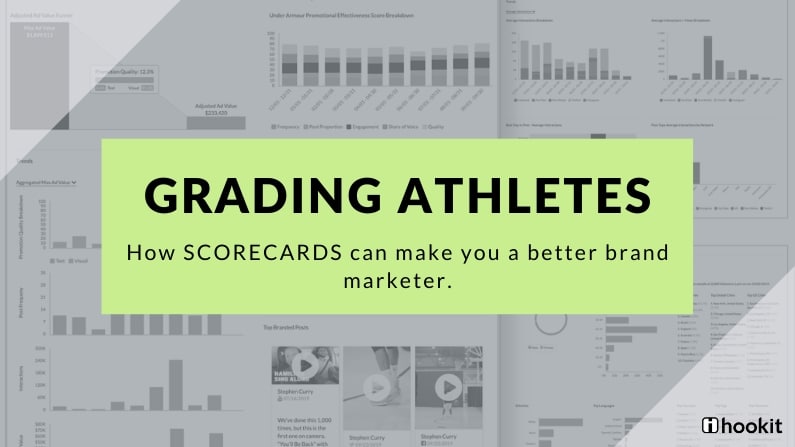Brands have been using sponsored properties and individuals to promote themselves and their products for many years. These brand ambassadors are chosen to help the brand grow and expand its horizons because they are considered to have significant influence over the audience the brand wants to reach. However, there are many questions that need to be answered when considering brand ambassadors :
- Is the brand sure the ambassador they have chosen is the right one?
- How well is this ambassador performing in relation to the brand’s goals?
- Is the ambassador a valuable asset to the brand?
- Who are other potential ambassadors the brand should look into?
- And more.
Brand sponsorships have evolved from gut feel or executive fandom, to measurable, performance-based partnerships. With the wealth of data available today, brands can measure the impact of their ambassadors and use these valuable insights to drive future sponsorship decisions.
To identify sponsorship value as a brand marketer, you must first understand the effectiveness of your sponsorships at promoting your brand. One way to do this is to look at the impact of social media promotion of your brand ambassadors using Scorecards – think of these as social media report cards for those you are paying to represent your brand.
Scorecards – A brief introduction
Hookit’s Scorecards are a great way for brands to gain a comprehensive understanding of how effective their brand ambassadors are on social media. Scorecards give advanced insights into the athletes, influencers, and properties that a brand is valuing or watching. From an ambassador’s scorecard, a brand can:
- Get in-depth analysis about the entity’s social media performance, sponsorship performance, analytics related to the ambassador’s branded posts on social, the social media audience of the ambassador, and more.
- Identify areas of excellence as well as areas for improvement for brand ambassadors, resulting in optimized social and sponsorship performance for the brand.
- Ability to benchmark between various brand ambassadors with top performers to understand how well the sponsored entity is performing in comparison.
- Make informed decisions about potential partners by watching their social and sponsorship performance to gauge how well they fit with the brand.
Scorecards – Social performance
For any brand marketer, it is important to first understand the performance of their sponsored properties on social media. The social performance of scorecards provides a comprehensive social media analysis and identifies areas of improvement to drive more engagement for the brand.
The social performance tab of a brand ambassador’s scorecard provides essential metrics required by every brand marketer. Following is a list of what they are and why they are important for brands:
1. Total social media followers and follower growth, trended by platform – The size of a brand ambassador’s social following is the audience that is available for a brand to market its products to. The larger the following, the higher the reach for the brand. Also, a steady growth in followers indicates that more people are interested in the ambassador and ultimately in the brands that they endorse.
2. Total and average social interactions, trended by platform – It’s not enough to just have a good social following, those followers should also actively engage with the brand ambassador. By looking at the engagement rate of the ambassador, the brand can gauge how much of their audience is engaging with the ambassador’s content.
3. Best post type – Every platform has a content type that is successful. Instagram is more visual with lots of images, while Twitter is predominantly text based. By figuring out which content resonates well with the ambassador’s audiences, brands can tweak their social and content strategy and drive successful campaigns.
4. Best days to post – Similar to content, there are also specific days where the ambassador’s posted content creates higher engagement. Understanding the best days to post and posting content that resonates with audiences will drive maximum engagement for the brand.
5. Mentions and hashtags most commonly used by the brand ambassador – These are the topics the ambassador talks about the most, including other brands, and how well each brand is promoted by the ambassador.
6. All social media posts by the brand ambassador – A tool for easy review of the types and frequency of the ambassador’s social posts.
Sample Scorecard

Below are some insights gleaned from the social performance tab of the above brand ambassador’s scorecard.
- With over 194M social media interactions plus views (8.3M interactions + 186M views) across her social channels, the ambassador has great engagement with her 27M+ social followers. [Top row numbers]
- Over the past 10 months, the major portion of the ambassador’s interactions were on Twitter, with other platforms leading in only May and July. [Trends Section, top left] The ambassador’s average social interactions saw a significant decline in September. A deeper dive into social posts (under the posts tab) by the ambassador can help the brand understand what causes this decline in interactions.
- As Twitter and YouTube were the social channels with most interactions, the ambassador can further maximize their engagement on these channels by posting on Sundays and Thursdays. [Trends Section, bottom left]
- Facebook videos performed very well in April & May. [Trends Section, top right] See the Posts tab to understand what these videos did well in order to recreate their success.
Scorecards – Sponsorship performance
With the wealth of data available now, it is easier than ever for brands to measure and value their sponsorships. Brands are now increasingly focusing on how well the ambassador promotes the brand on social media and the value driven by these promotions. Some brands have even started migrating to incentive/performance-based sponsorships, where the best brand promoters earn higher rewards.
Brands can accurately understand the levers that drive value for a brand through an ambassador’s Sponsorship Performance tab on their Scorecard. There are two types of sponsorship performance metrics available on Scorecards – Brand sponsorship (analyzes just the sponsor brand) and Overall sponsorship (analyzes sponsorship performance across all sponsors of the brand ambassador). Following is a list of what they are and why they are important for brands –
Brand Sponsorship – Analyzes just the sponsor brand
1. Branded post ratio / branded engagement ratio – This metric indicates what percentage of the ambassador’s posts feature the sponsor brand and the ratio of engagement on those posts. Comparing this ratio with the overall branded post ratio of the ambassador can help sponsor brands learn how well their promoted posts are received compared to other sponsor brands of the ambassador.
2. Maximum Ad Value (MAV), Adjusted Ad Value (AAV) funnel, and Promo Quality – To accurately gauge the value a sponsor earns from its branded posts, Hookit employs its proprietary Hookit Valuation Model (HVM). The HVM starts with the MAV, which is the total value the brand could earn from that particular social post. This MAV is then scored against the post’s quality of promotion to arrive at the AAV. It is therefore important to ensure that branded posts have good promotion quality to maximize their value earned. Get the full details of the Hookit Valuation Model and promotion quality here. Brands can use this funnel to easily understand how much value they earned from their ambassador’s promoted posts.
3. Promotional Effectiveness (PE) Score (current and trended) – A composite score developed by Hookit, the PE score shows brands how effective their ambassador is at promoting the brand. Since brands can lose sponsorship value if the ambassador’s promotion is poor, brands can use the PE score to learn how effective their ambassador is at promoting them. Comparing this brand specific score with the overall PE score of the ambassador can further the brand’s understanding of how well the ambassador is at promoting the brand vs other sponsor brands.
4. Trends on branded posts for promotion quality, frequency, interactions and AAV – Using these trends, brands can understand more about their branded posts. For example, a brand can learn if more frequency of posts leads to more interactions, or if a text based post generated more value than an image based post, and more.
5. Promotional Tag Performance – This metric helps brands understand the individual performance of their hashtags, mentions and brand logo (interactions and value generated) on the ambassador’s social channels. This enables brands to learn about their best performing hashtags, optimum placement of brand logos and more, helping them strategize their future campaigns more effectively.
Overall Sponsorship – Comparing the brand’s sponsorship metrics across all other sponsor brands of the ambassador, provides a useful benchmark for the sponsor brand.
An example

Below are some insights gleaned from the brand sponsorship performance tab of the above brand ambassador’s scorecard.
- The Max Ad Value (MAV) generated from the ambassador’s social media posts within the past 10 months was $1.9M. However due to poor quality of promotion (3.1%) by the ambassador, the brand only earned $233k from branded posts. If the same MAV was earned by an ambassador with a better promotion quality, then the AAV that the brand earned would be much higher.
- Component values of the PE score have been constant (with a slight dip in June) across the time period considered. Providing best practices to the ambassador can help tweak the individual components to achieve better scores, chiefly in promotion quality.
- Majority of branded posts feature the brand logo, and these posts have the highest social interactions and generated the highest AAV. This tells the brand that the ambassador has optimum placement of the brand’s logo on his/her posts. The brand can also use the ambassador’s posts as a best practice example to coach their other ambassadors on how to place the logo for maximum engagement.
- Higher frequency of posts does not necessarily lead to higher interactions or higher brand value. It is important to find a good balance between the number of posts and promotion quality.
Scorecards – Audience analysis
A comprehensive understanding of a brand ambassador’s audience benefits the brand in a number of ways. By learning about the interests of their audience, a brand ambassador can create content that resonates with those fans, leading to better engagement on branded posts and value for partner brands.
From the audience analysis of an ambassador’s scorecard, brands can learn about audience demographics and psychographics such as age group, gender, location, languages, interests, social behavior and more. Currently, Twitter analysis is available for every entity in the Hookit Sport Graph. With privacy restrictions on Instagram and Facebook, audience data from these platforms is only available for sponsored entities that have authenticated their accounts with Hookit.
All this data not only benefits the ambassador to be able to engage their audience more, but also benefits the brand. The brand marketers can use this data to choose which ambassadors to promote which products or to feature in new campaigns that are targeted toward specific audiences that the ambassador can engage.
An example

Below are some insights gleaned from the Audience tab of the above brand ambassador’s scorecard.
- The brand ambassador’s Instagram and Facebook audience is predominantly made up of male fans within the 18-44 age groups. A similar trend can also be seen among the ambassador’s Twitter followers.
- Nearly 90% of the ambassador’s followers speak Spanish as their primary language.
- This is a great audience group for a brand who wants to reach and engage with Hispanic men with major interests in sports and family/parenting.



